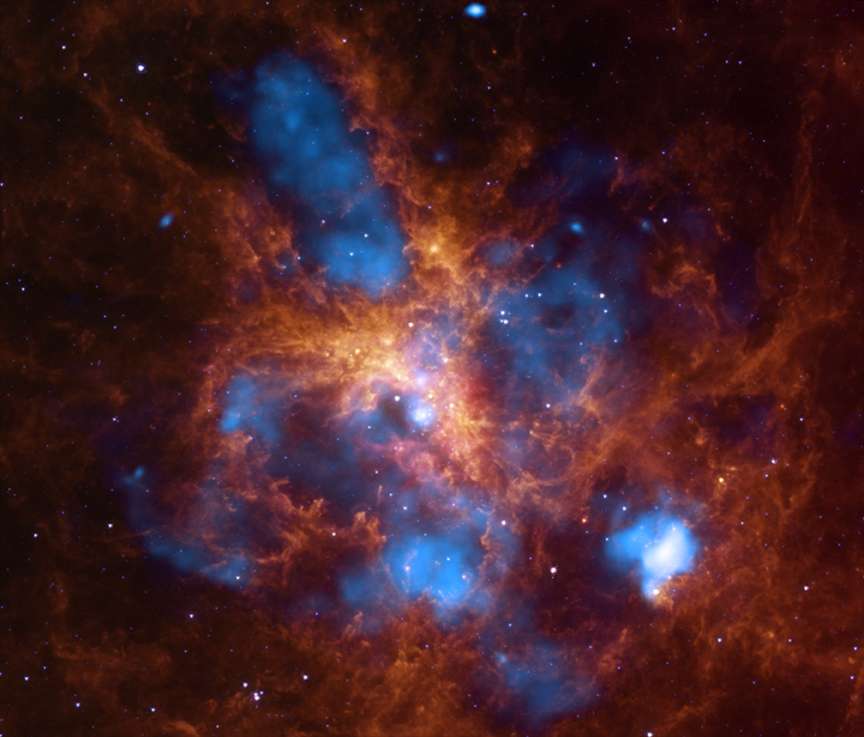One of the most spectacular objects in the sky, the Tarantula Nebula, is located in a nearby dwarf galaxy, a satellite of our Milky Way. In various catalogs, it appears as NGC 2070 or ESO 57-EN6. Also behind it is another one, the old name is 30 Golden Fish. Let’s try to figure out what it is and why it is so attractive to both professional astronomers and amateurs.
How far is NGC 2070 and how big is it
The nebula is located in the Large Magellanic Cloud. It is separated from us by approximately 170 thousand light-years (about 52 parsecs). In Russia, it is not observed. It can be seen while in the Southern Hemisphere and in the low latitudes of the Northern Hemisphere, since the constellation Golden Fish, to which the nebula is “assigned”, is located quite close to the southern pole of the celestial sphere.
Its visible dimensions are 30 to 20 arc minutes. This means that the nebula is actually huge: if we mentally placed it at the same distance that separates the closest star formation region from us - the Large molecular Orion Cloud - we would see an object 60 times the apparent diameter of the Moon. The large diameter of NGC 2070 is about a thousand light-years.
What is a Tarantula
Astronomers of the past, who did not have such powerful observational tools that modern scientists have at their disposal, considered the nebula NGC 2070 to be a bright star, and therefore assigned it a completely "star" name - 30 Golden Pisces.
However, it later became clear that the so-called “star” is in fact a giant emission nebula, an ionized hydrogen cloud, intensively emitting in the ultraviolet and optical range. Such clouds are characterized by active processes of the birth of very hot stars.
The silhouette formed by the nebula, obviously, reminded the observers of the shape of a spider, and the object received the unofficial, but very common name "Tarantula".
Tarantula Nebula Structure
Astronomers were able to get an idea of the structure of ESO 57-EN6 when the development of observational technology made it possible to obtain high-resolution images at different wavelengths. It turned out that the most large-scale structural elements of the nebula are hot bubbles radiating in the x-ray range of the gas. To such high temperatures, this interstellar gas was heated by shock waves from supernova explosions, as well as by the hard radiation of young giant stars and supergiants. The combined photo, in which an infrared image (orange) is superimposed on an X-ray (blue), presented below, clearly demonstrates these huge bubbles.

It is precisely such bright stars of large masses and luminosities that are concentrated in the central part of the nebula. There is the R136 cluster, the age of stars in which is estimated at about 2 million years - similar stars in astrophysics are considered young. NGC 2070 contains several more groups of young luminaries not older than 30 million years. As for the peripheral regions, there are globular star clusters, also of small age.
Cluster R136
The cluster includes over 100 thousand stars, and the small extent indicates that the bright luminaries are very densely packed in it. Often collisions occur, more precisely, mergers, as a result of which, as expected, supermassive stars can form. There are too many such monsters in the R136 cluster, and it is difficult to explain their number in any other way.
The cluster itself has an uneven structure: in its composition there is a supercompact component with an anomalously large number of very bright and, therefore, massive stars. They are more than 35 times, and some more than 100 times superior to the Sun in this parameter. Their surface is heated up to more than 40 thousand kelvin.
It is assumed that R136 will eventually turn into a globular cluster, similar to those already in the Tarantula Nebula.
Brightest star
An interesting and in many ways still mysterious phenomenon is the star R1361a. She is precisely the champion among supergiants of an unusual cluster. This monster is 265 times more massive than the Sun, and at birth, according to some estimates, it could have a mass of 320 times the size of the Sun. The fact is that such heavy and hot objects intensively lose matter - it simply “tolerates” radiation pressure. The luminosity of a star, that is, its power, is thus approximately 9 million times greater than the luminosity of our dear Sun. Today, R1361a is considered the star with the highest luminosity of all known.
The problem is that the existence of such objects cannot yet be explained in the framework of the modern model of star evolution, which works perfectly far from this extreme boundary. But if the observational fact does not agree with the model, then the fact is not “guilty”, but the model. Well, all the more interesting - because the model needs to be refined, during which new discoveries are possible.
Treasury in the Large Magellanic Cloud
NGC 2070 is a very valuable source of information for astrophysicists. So extreme objects located close enough to be able to observe them in good resolution, at the disposal of scientists - a few units.
One of the pillars of astrophysics is the theory of stellar evolution, which, as we have seen, needs to be clarified. Perhaps it is the study of the Tarantula emission nebula that will allow this to be done. In addition, most of her stars are extremely massive, characterized by a short life with a stormy finale. It seems that scientists have the right to expect a supernova outburst in NGC 2070, which would significantly supplement our knowledge of the Universe. Observational data on supernova remnants suggest that supernovae should be a frequent occurrence here.
A detailed map of the Tarantula Nebula is being compiled, which is designed to help better understand its structure. Well, we will admire the wonderful pictures of this beautiful space structure and expect news about it.